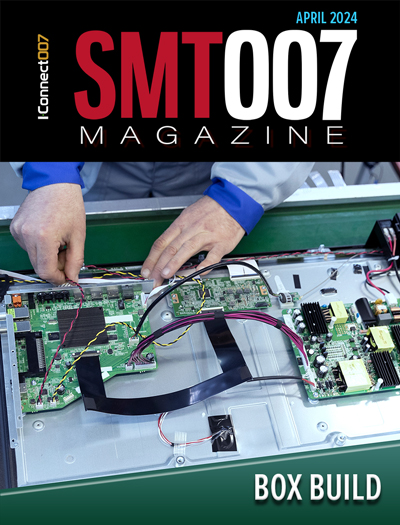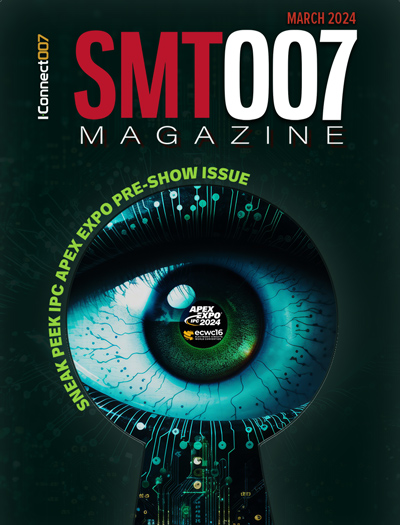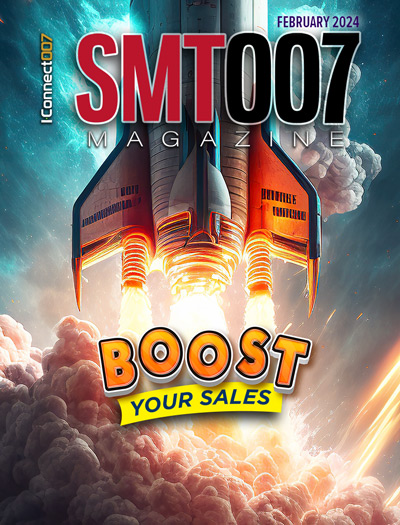-

- News
- Books
Featured Books
- smt007 Magazine
Latest Issues
Current Issue
Box Build
One trend is to add box build and final assembly to your product offering. In this issue, we explore the opportunities and risks of adding system assembly to your service portfolio.

IPC APEX EXPO 2024 Pre-show
This month’s issue devotes its pages to a comprehensive preview of the IPC APEX EXPO 2024 event. Whether your role is technical or business, if you're new-to-the-industry or seasoned veteran, you'll find value throughout this program.

Boost Your Sales
Every part of your business can be evaluated as a process, including your sales funnel. Optimizing your selling process requires a coordinated effort between marketing and sales. In this issue, industry experts in marketing and sales offer their best advice on how to boost your sales efforts.
- Articles
- Columns
Search Console
- Links
- Events
||| MENU - smt007 Magazine
A Review of the Opportunities and Processes for Printed Electronics (Part 5): The Future of PE
June 26, 2015 | Happy Holden, PCB Technologist-RetiredEstimated reading time: 11 minutes
Flexible thin-film solar cells on plastic film have enormous potential. New applications will take advantage of their attributes of being lightweight and flexible. Applications include solar cells on T-shirts and jackets, modules on cars, boats and light aircraft, mobile and camping energy and novel toys like LED night kites. Since these materials can be tailored to shapes, architectural drapes and roof and wall coatings are all practical.
Figure 1: OE-A roadmaps give a best guess on how rapidly the PE market will develop.
Batteries/energy storage
An energy technology that is complementary and compatible with flexible solar cells is thin flexible batteries made in similar ways to CIGS thin-film PC devices. There are electrodes in the battery, but instead of generating electricity, electrolytes will store electricity. Zinc manganese dioxide (ZnMnO2) is a typical electrolyte, as is lithium-ion (Li-ion).
The novelty of these inexpensive batteries is that they can be eco-friendly, single-use and disposable without causing pollution, releasing any toxic compounds or combusting. They can be used in innovations such as cosmetic teeth whitening, anti-aging electric wrinkle care and moisturizing, electrophoresis hair removal, RFID, toys and even medicine delivery.
Thin flexible batteries can be made out of simple paper (as thin as 0.6mm) using a spacer that is made largely of cellulose and printed with carbon nanotubes with electrolytes that are soaked into the paper. The batteries are available in 1.5, 3, 4.5 and 6V at 4.5mAh/cm2 and weigh less than a gram. They can have a shelf life of three years and can operate at temperatures ranging from -20°C to 60°C. These green batteries are produced by screen printing, disposable and free of toxic chemicals. They cannot overheat, explode or cause burns and are non-toxic and non-flammable. Power Paper of Israel has perfected this technology. There are other companies producing thin flexible batteries.
The most exciting of these new developments is from Planar Energy, a spin-off of the US National Renewable Energy Center in Colorado. Their solid-state nanofilm electrolysis technology produces conductivity metrics equivalent to liquid electrolytes with three times the energy density of current Li-ion batteries and cost less than half the price per kilowatt hour. Their roll-to-roll deposition process is called SPEED (Streaming Protocol for Electroless Electrochemical Deposition). Thin-film nanomaterials are deposited sequentially on the flexible substrate, resulting in lower costs and increased control compared to vacuum deposition.
Low cost e-paper and other PE displays continue to be a major research focus. In addition to OLED technology on flex, there is also electrophoretic, electrochromic and electroluminescent displays. OLED displays are used in mobile phones. They use Universal Display's phosphorescent red, green and blue OLED materials, which have been proven to significantly reduce power consumption in numerous glass-based AMOLED products.
Figure 2: Displays.
The displays use an active matrix array of thin-film transistors fabricated on DuPont Teijin Films Teonex film using substrate handling and processing technologies developed at the Flexible Display Center (FDC) at Arizona State University. Versions using transistors made with both low-temperature amorphous silicon and higher performance indium gallium zinc oxide have been produced.
It was previously thought that amorphous silicon backplanes were unsuitable for OLED due to stability problems. However, Ignis Innovation has solved the stability problems, paving the way for this first product.
"The performance is equivalent to polysilicon AMOLED. The product also incorporates Ignis’s latest all-in-one driver chip for amorphous silicon AMOLED, which is the first of its kind in today's AMOLED market," says Paul Arsenault, president and CEO. "This opens the door for RiTdisplay and other manufacturers to make state-of-the-art AMOLED displays using existing amorphous silicon equipment that is currently being used for LCD. This is the start of a new era where AMOLED displays can be made in much greater volumes, and with lower cost, than they are today with polysilicon."
Ignis Innovation is the leading provider of technology that makes AMOLED displays last longer, look better and cost less. Ignis works with display manufacturers to improve AMOLED displays using innovative circuit designs, driving algorithms and embedded software.
RiTdisplay, established in 2000, is the first company in Taiwan devoted in OLED research and development and manufacturing. It is currently the only company capable of manufacturing both OLED and polymer light-emitting diode (PLED) products. By adopting a customer-oriented marketing strategy together with the most advanced technology capability, RiTdisplay offers the most advanced display products to meet the demand in a variety of applications.
The different OLED manufacturing process lends itself to several advantages over flat-panel displays made with LCD technology.
Lower cost in the future
OLEDs can be printed onto any suitable substrate by an inkjet printer or even by screen printing, theoretically making them cheaper to produce than LCD or plasma displays. However, fabrication of the OLED substrate is more costly than that of a TFT LCD, until mass production methods lower cost through scalability. Roll-to-roll vapor deposition methods for organic devices allow mass production of thousands of devices per minute for minimal cost. However, this technique can induce problems due to the challenges associated with manufacturing multilayer devices.
Page 1 of 3
Suggested Items
Koh Young Showcases Award-winning Inspection Solutions at SMTconnect with SmartRep in Hall 4A.225
04/25/2024 | Koh Young TechnologyKoh Young Technology, the industry leader in True 3D measurement-based inspection solutions, will showcase an array of award-winning inspection and measurement solutions at SMTconnect alongside its sales partner, SmartRep, in booth 4A.225 at NürnbergMesse from June 11-13, 2023. The following offers a glimpse into what Koh Young will present at the tradeshow:
Real Time with… IPC APEX EXPO 2024: Plasmatreat: Innovative Surface Preparation Solutions
04/25/2024 | Real Time with...IPC APEX EXPOIn this interview, Editor Nolan Johnson speaks with Hardev Grewal, CEO and president of Plasmatreat, a developer of atmospheric plasma solutions. Plasmatreat uses clean compressed air and electricity to create plasma, offering environmentally friendly methods for surface preparation. Their technology measures plasma density for process optimization and can remove organic micro-contamination. Nolan and Hardev also discuss REDOX-Tool, a new technology for removing metal oxides.
Nanotechnology Market to Surpass $53.51 Billion by 2031
04/25/2024 | PRNewswireSkyQuest projects that the nanotechnology market will attain a value of USD 53.51 billion by 2031, with a CAGR of 36.4% over the forecast period (2024-2031).
Cadence, TSMC Collaborate on Wide-Ranging Innovations to Transform System and Semiconductor Design
04/25/2024 | Cadence Design SystemsCadence Design Systems, Inc. and TSMC have extended their longstanding collaboration by announcing a broad range of innovative technology advancements to accelerate design, including developments ranging from 3D-IC and advanced process nodes to design IP and photonics.
SMC Korea 2024 to Highlight Semiconductor Materials Trends and Innovations on Industry’s Path to $1 Trillion
04/24/2024 | SEMIWith Korea a major consumer of semiconductor materials and advanced materials a key driver of innovation on the industry’s path to $1 trillion, industry leaders and experts will gather at SMC (Strategic Materials Conference) Korea 2024 on May 29 at the Suwon Convention Center in Gyeonggi-do, South Korea to provide insights into the latest materials developments and trends. Registration is open.


